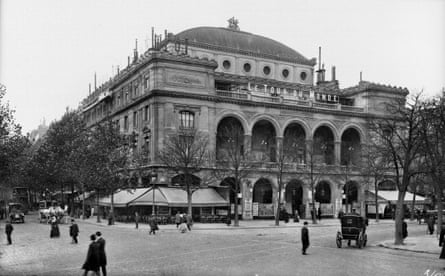Paris’s Châtelet theatre will reopen this week as the “people’s theatre” after a two-year, £28.6m restoration. The 19th-century building will return with a street parade from the nearby Hôtel de Ville to the theatre featuring giant puppets from Mozambique followed by an “extreme” acrobatic show.
It will be the first time the Châtelet’s British artistic director, Ruth Mackenzie, appointed in January 2017, has overseen a production in her own theatre, though she insists: “This isn’t my theatre; it belongs to every single citizen of Paris because they’ve paid their taxes, so they’ve already paid for this place. It is literally their theatre. It belongs to the people and the artists and it’s great to have them back.”
Mackenzie, formerly of the Scottish Opera and Nottingham Playhouse, had just arrived in Paris to take charge with co-director Thomas Lauriot dit Prévost when the theatre – deemed a fire and safety risk – was shut.
“Theatres aren’t built to be closed, so it’s been rather a sad place during the work, but to come back with 200 performers and 2,000 people in the audience is so thrilling,” she said.
Sitting in the re-upholstered velvet seats on the first-floor balcony, Mackenzie said she was still discovering the nooks and crannies of the Châtelet. “There’s quite a bit of legroom, which is good,” she said. “And look at all the marvellous different coloured golds in the auditorium.” She pointed to a painter touching up a gilt pillar somewhere up near the gods, where plump golden cherubs brandish musical instruments.
Not everything is going smoothly. Theatre staff stared dismally as water poured through a hole in the ceiling into a bucket in the middle of a puddle. But Mackenzie kept calm, smiled and carried on. “If there’s a problem, I just tell people: we open next week,” she said.
The Théâtre du Châtelet sits on the right bank of the Seine in Paris’s 1st arrondissement. It was built on the orders of Napoleon III’s chief architect, Baron Haussmann, as part of the “great transformation” of the French capital during the Second Empire and opened in 1862.
In the 20th century it played host to ballet dancers Vaslav Nijinsky and Anna Pavlova, and composers Debussy, Ravel and Stravinsky. More recently it has become known as Broadway-sur-Seine for its staging of classic Broadway musicals.
Mackenzie and Lauriot dit Prévost have made no secret of the fact that they intend to take the theatre in a different direction, reviving its reputation as a place of cultural innovation by turning it into what Lauriot dit Prévost calls an “activist” theatre. This will involve opening its stage to less well-known French and international artists, involving community groups in performances and encouraging more people into the theatre.

One of their first acts has been to introduce a “Robin Hood scheme” for theatregoers and sponsors to buy extra tickets for those who cannot afford them. The Châtelet is also offering 10,000 €10 tickets a year to the under-25s.
Parade, the opening spectacle, is a tribute to the ballet of the same name created by French composer and pianist Erik Satie, based on a poem by Jean Cocteau and with scenery by Pablo Picasso, staged at the Châtelet by the legendary Ballets Russes under its founder Serge Diaghilev in 1917.
It will be followed by Les Justes, a musical adaptation of Albert Camus’ work staged by French rapper-songwriter Abd Al Malik. To keep the previous Broadway-loving audience happy, the Christmas programme includes a return of the musical An American in Paris, followed next year by the Glyndebourne festival’s production of Handel’s Saul; Perle Noire: Méditations pour Joséphine (Baker) directed by American Peter Sellars; a homage to “Mama Africa”, Miriam Makeba, by the Malian singer Rokia Traoré; Cinderella by the Dutch National Ballet; and Giselle by the English National Ballet.
Mackenzie, who has served as a special adviser to UK culture ministers, as director of the London 2012 festival, has also used the theatre’s renovation and reopening to introduce more gender equality. The Châtelet’s nine foyers, all previously named after men, have been renamed to include celebrated female performers, including Juliette Greco and Josephine Baker.
The disparity between male and female staff salaries has been reduced by 3.7% in management – the average in France is 24% in favour of men.
“Women junior staff are actually paid more than the men, so we’re having to rebalance that a bit,” Mackenzie said.
Mackenzie’s aim is to make the Châtelet a place for all. “What we are trying to do is make the theatre reflect our values,” she said. “And those values are that everyone can be an artist, everyone can get involved in the theatre, and everyone can come.”
